Analysis of the Quasi-Static and Dynamic Fracture of the Silica Refractory Using the Mesoscale Discrete Element Modelling
Abstract
:1. Introduction
2. Materials and Methods
2.1. Material and Laboratory Tests
2.2. DEM Models
2.3. Homogeneously Deformable Discrete Elements
2.3.1. The Linear–Elastic Behaviour of Discrete Elements
2.3.2. Quasi-Static Model of Local Fracture
2.3.3. Modelling of the Grain–Matrix Interfaces
2.3.4. Dynamic Formulation of Fracture Criterion
2.4. Model Parameters
3. Results and Discussion
3.1. Validation of the Model and the Adjustment of the Local Properties
3.1.1. Quasi-Static Fracture Criterion
3.1.2. Strength of Constituents
3.1.3. Properties of the Interface
3.1.4. Influence of Finite Time of Fracture Incubation
3.2. Dynamic Mechanical Behaviour
4. Conclusions
- An acceptable agreement was seen between the loading rate dependencies predicted by the model and average experimental trend typical for brittle and quasi-brittle materials. Particularly, the simulation results showed a non-linear increase of compressive and tensile strength of refractory with increasing strain rate. In both cases, the dynamic strength curves can be approximated by power functions with exponents significantly less than 1. The exponent for dynamic tensile strength is 1.4 times greater than the exponent for dynamic compressive strength. These results correlate well with experimental data on diverse heterogeneous ceramic-based materials, including concretes and rocks. Experimental data show that, first, the dependences DIF () are power functions with exponents usually around 0.5, and, second, the exponent for tensile DIF is up to two times greater than for compressive DIF [50,51,52,53]. The simulation results also indicate a transition from localised fracture (single macrocracks) to multiple fractures (branching network of mesocracks) and a progressive increase in the degree of sample fragmentation with increasing strain rate. The effect is especially pronounced at > 101 s−1. This is also in good agreement with the dynamic test results of diverse quasi-brittle porous materials. Finally, it is pertinent to mention the increase in the number of broken mesoscopic hard inclusions at high strain rates observed in experiment and simulation (the trend from crack propagation around the inclusions to cutting them).
- The disproportional (power law) increase of the strength and fracture energy with the loading rates signals a reduced brittleness for the refractories under higher dynamic loading rates. On the microstructural level, this is seen by a more dispersed failure process and a higher fraction of large grain failure typically observed for higher rates of loading. A detailed experimental and computational study of this effect is the subject of further research.
- The compressive properties are more sensitive to the interface strength than the tensile properties. Under tension, a significant variation of the crack trajectory is observed despite the limited sensitivity of the global strength on the strength of the interface.
- The variation of the interface strength has a quantitatively similar effect on the quasi-static and dynamic compressive strength of the material.
- For tensile loading, the dependencies of strength on the loading rate for models with different interface strengths are less similar than those for compressive loading. This can indicate that the change in the contributions of different constituents to the sample damage with an increase in the tensile strain rate substantially depends on the static strength of the interfaces. A detailed analysis of this effect can be the subject of further research.
Supplementary Materials
Author Contributions
Funding
Conflicts of Interest
References
- Shinohara, Y. Refractories Handbook; Japanese Association of Refractories: Tokyo, Japan, 1998. [Google Scholar]
- Schacht, C. Refractory Linings: Thermomechanical Design and Applications; CRC Press: Boca Raton, FL, USA, 2019. [Google Scholar]
- Harmuth, H.; Bradt, R.C. Investigation of refractory brittleness by fracture mechanical and fractographic methods. Interceram Int. Ceram. Rev. 2010, 1, 6–10. [Google Scholar]
- Ludwig, M.; Śnieżek, E.; Jastrzębska, I.; Prorok, R.; Sułkowski, M.; Goławski, C.; Fischer, C.; Wojteczko, K.; Szczerba, J. Recycled magnesia-carbon aggregate as the component of new type of MgO-C refractories. Constr. Build. Mater. 2021, 272, 121912. [Google Scholar] [CrossRef]
- Madej, D.; Szczerba, J. Detailed studies on microstructural evolution during the high temperature corrosion of SiC-containing andalusite refractories in the cement kiln preheater. Ceram. Int. 2017, 43, 988–1996. [Google Scholar] [CrossRef]
- Yao, H.; Chen, H.; Ge, Y.; Wei, H.; Li, Y.; Saxén, H.; Wang, X.; Yu, Y. Numerical Analysis on Erosion and Optimization of a Blast Furnace Main Trough. Materials 2021, 14, 4851. [Google Scholar] [CrossRef]
- Gómez-Rodríguez, C.; Antonio-Zárate, Y.; Revuelta-Acosta, J.; Verdeja, L.F.; Fernández-González, D.; López-Perales, J.F.; Rodríguez-Castellanos, E.A.; García-Quiñonez, L.V.; Castillo-Rodríguez, G.A. Research and Development of Novel Refractory of MgO Doped with ZrO2 Nanoparticles for Copper Slag Resistance. Materials 2021, 14, 2277. [Google Scholar] [CrossRef]
- Tang, H.; Li, C.; Gao, J.; Touzo, B.; Liu, C.; Yuan, W. Optimization of Properties for Alumina-Spinel Refractory Castables by CMA (CaO-MgO-Al2O3) Aggregates. Materials 2021, 14, 3050. [Google Scholar] [CrossRef] [PubMed]
- Ratle, A.; Allaire, C. A new method for impact testing of refractories. J. Can. Ceram. Soc. 1996, 65, 263–269. [Google Scholar]
- Gruber, D.; Sistaninia, M.; Fasching, C.; Kolednik, O. Thermal shock resistance of magnesia spinel refractories—Investigation with the concept of configurational forces. J. Eur. Cer. Soc. 2016, 36, 4301–4308. [Google Scholar] [CrossRef]
- Asadi, F.; André, D.; Emam, S.; Doumalin, P.; Huger, M. Numerical modelling of the quasi-brittle behaviour of refractory ceramics by considering microcracks effect. J. Eur. Ceram. Soc. 2021, in press. [Google Scholar] [CrossRef]
- Andreev, K.; Yin, Y.; Luchini, B.; Sabirov, I. Failure of refractory masonry material under monotonic and cyclic loading—Crack propagation analysis. J. Con. Build. Mat. 2021, 299, 124203. [Google Scholar] [CrossRef]
- Zabolotkskiy, A.V.; Turchin, M.Y.; Khadyev, V.T.; Migashkin, A.O. Numerical investigation of refractory stress-strain condition under transient thermal load. AIP Conf. Proc. 2020, 2310, 020355. [Google Scholar] [CrossRef]
- Harmuth, H. Characterisation of the Fracture Path in ‘Flexible’ Refractories. Adv. Sci. Technol. 2010, 70, 30–36. [Google Scholar] [CrossRef]
- Rossello, C.; Elices, M. Fracture of model concrete: 1. Types of fracture and crack path. Cem. Concr. Res. 2004, 34, 1441–1450. [Google Scholar] [CrossRef]
- Rossello, C.; Elices, M.; Guinea, G.V. Fracture of model concrete: 2. Fracture energy and characteristic length. Cem. Concr. Res. 2006, 36, 1345–1353. [Google Scholar] [CrossRef]
- Brandt, A.J. Cement-Based Composites; CRC Press: London, UK, 2014. [Google Scholar] [CrossRef]
- Mao, Y.; Coenen, J.W.; Riesch, J.; Sistla, S.; Almanstötter, J.; Jasper, B.; Terra, A.; Höschen, T.; Gietl, H.; Linsmeier, C.; et al. Influence of the interface strength on the mechanical properties of discontinuous tungsten fiber-reinforced tungsten composites produced by field assisted sintering technology. Compos. A Appl. Sci. Manuf. 2018, 107, 342–353. [Google Scholar] [CrossRef]
- Sabirov, I.; Kolednik, O. Local and global measures of the fracture toughness of metal matrix composites. Mater. Sci. Eng. A 2010, 527, 3100–3110. [Google Scholar] [CrossRef]
- Smirnov, I.; Konstantinov, A. Strain Rate Dependencies and Competitive Effects of Dynamic Strength of Some Engineering Materials. Appl. Sci. 2020, 10, 3293. [Google Scholar] [CrossRef]
- Henneberg, D.; Ricoeur, A.; Judt, P. Multiscale modeling for the simulation of damage processes at refractory materials under thermal shock. Comput. Mater. Sci. 2013, 70, 187–195. [Google Scholar] [CrossRef]
- Makarian, K.; Santhanam, S. Micromechanical modeling of thermo-mechanical properties of high volume fraction particle-reinforced refractory composites using 3D Finite Element analysis. Ceram. Int. 2020, 46, 4381–4393. [Google Scholar] [CrossRef]
- Šavija, B.; Smith, G.E.; Liu, D.; Schlangen, E.; Flewitt, P.E.J. Modelling of deformation and fracture for a model quasi-brittle material with controlled porosity: Synthetic versus real microstructure. Eng. Fract. Mech. 2019, 205, 399–417. [Google Scholar] [CrossRef] [Green Version]
- Šavija, B.; Zhang, H.; Schlangen, E. Assessing hydrated cement paste properties using experimentally informed discrete models. J. Mater. Civ. Eng. 2019, 31, 04019169. [Google Scholar] [CrossRef] [Green Version]
- Andreev, K.; Sinnema, S.; Stel, J.; Allaoui, S.; Blond, E.; Gasser, A. Effect of binding system on the compressive behaviour of refractory mortars. J. Eur. Ceram. Soc. 2014, 34, 3217–3227. [Google Scholar] [CrossRef]
- Luchini, B.; Sciuti, V.F.; Angélico, R.A.; Canto, R.B.; Pandolfelli, V.C. Critical inclusion size prediction in refractory ceramics via finite element simulations. J. Eur. Ceram. Soc. 2017, 37, 315–321. [Google Scholar] [CrossRef]
- Moreira, M.H.; Cunha, T.M.; Campos, M.G.G.; Santos, M.F.; Santos, T., Jr.; Andrfe, D.; Pandolfelli, V.C. Discrete element modelling—A promising method for refractory microstructure design. Am. Ceram. Soc. Bull. 2020, 99, 22–28. [Google Scholar]
- Nguyen, T.T.; André, D.; Huger, M. Analytical laws for direct calibration of discrete element modelling of brittle elastic media using cohesive beam model. Comput. Part. Mech. 2019, 6, 393–409. [Google Scholar] [CrossRef] [Green Version]
- Samadi, S.; Jin, S.; Harmuth, H. Combined damaged elasticity and creep modeling of ceramics with wedge splitting tests. Ceram. Int. 2021, 47, 25846–25853. [Google Scholar] [CrossRef]
- Moreira, M.H.; Ausas, R.F.; Dal Pont, S.; Pelissari, P.I.; Luz, A.P.; Pandolfelli, V.C. Towards a single-phase mixed formulation of refractory castables and structural concrete at high temperatures. Int. J. Heat Mass Transf. 2021, 171, 121064. [Google Scholar] [CrossRef]
- Li, W.; Zhou, X.; Carey, J.W.; Frash, L.P.; Cusatis, G. Multiphysics lattice discrete particle modeling (M-LDPM) for the simulation of shale fracture permeability. Rock Mech. Rock Eng. 2018, 51, 3963–3981. [Google Scholar] [CrossRef] [Green Version]
- Sadowski, T.; Pankowski, B. Numerical modelling of two-phase ceramic composite response under uniaxial loading. Compos. Struct. 2016, 143, 388–394. [Google Scholar] [CrossRef]
- Moës, N.; Dolbow, J.; Belytschko, T. A finite element method for crack growth without remeshing. Int. J. Numer. Methods Eng. 1999, 46, 131–150. [Google Scholar] [CrossRef]
- Mohammadnejad, T.; Khoei, A. An extended finite element method for hydraulic fracture propagation in deformable porous media with the cohesive crack model. Finite Elem. Anal. Des. 2013, 73, 77–95. [Google Scholar] [CrossRef]
- Cusatis, G.; Pelessone, D.; Mencarelli, A. Lattice discrete particle model (LDPM) for failure behavior of concrete. I: Theory. Cem. Concr. Compos. 2011, 33, 881–890. [Google Scholar] [CrossRef]
- Rezakhani, R.; Zhou, X.; Cusatis, G. Adaptive multiscale homogenization of the lattice discrete particle model for the analysis of damage and fracture in concrete. Int. J. Solids Struct. 2017, 125, 50–67. [Google Scholar] [CrossRef]
- Potyondy, D.O.; Cundall, P.A. A bonded-particle model for rock. Int. J. Rock Mech. Min. Sci. 2004, 41, 1329–1364. [Google Scholar] [CrossRef]
- Jebahi, M.; Andre, D.; Terreros, I.; Iordanoff, I. Discrete Element Method to Model 3D Continuous Materials; Wiley: London, UK, 2015. [Google Scholar]
- Psakhie, S.G.; Shilko, E.V.; Grigoriev, A.S.; Astafurov, S.V.; Dimaki, A.V.; Smolin, A.Y. A mathematical model of particle–particle interaction for discrete element based modeling of deformation and fracture of heterogeneous elastic–plastic materials. Eng. Fract. Mech. 2014, 130, 96–115. [Google Scholar] [CrossRef]
- Psakhie, S.G.; Shilko, E.V.; Schmauder, S.; Popov, V.L.; Astafurov, S.V.; Smolin, A.Y. Overcoming the limitations of distinct element method for multiscale modeling of materials with multimodal internal structure. Comput. Mater. Sci. 2015, 102, 267–285. [Google Scholar] [CrossRef]
- Dmitriev, A.I.; Österle, W.; Wetzel, B.; Zhang, G. Mesoscale modeling of the mechanical and tribological behavior of a polymer matrix composite based on epoxy and 6 vol.% silica nanoparticles. Comput. Mater. Sci. 2015, 110, 204–214. [Google Scholar] [CrossRef]
- Andreev, K.; Tadaion, V.; Zhu, Q.; Wang, W.; Yin, Y.; Tonnesen, T. Thermal and mechanical cyclic tests and fracture mechanics parameters as indicators of thermal shock resistance—Case study on silica refractories. J. Eur. Cer. Soc. 2019, 39, 1650–1659. [Google Scholar] [CrossRef]
- Starinshak, D.P.; Owen, J.M.; Johnson, J.N. A new parallel algorithm for constructing Voronoi tessellations from distributed input data. Comput. Phys. Commun. 2014, 185, 3204–3214. [Google Scholar] [CrossRef] [Green Version]
- Psakhie, S.; Shilko, E.; Smolin, A.; Astafurov, S.; Ovcharenko, V. Development of a formalism of movable cellular automaton method for numerical modeling of fracture of heterogeneous elastic-plastic materials. Frattura Integr. Strutt. 2013, 24, 26–59. [Google Scholar] [CrossRef] [Green Version]
- Shilko, E.V.; Konovalenko, I.S.; Konovalenko, I.S. Nonlinear mechanical effect of free water on the dynamic compressive strength and fracture of high-strength concrete. Materials 2021, 14, 4011. [Google Scholar] [CrossRef]
- Jing, L.; Stephansson, O. Fundamentals of Discrete Element Method for Rock Engineering: Theory and Applications; Elsevier: Amsterdam, The Netherlands, 2007. [Google Scholar]
- Drucker, D.C.; Prager, W. Soil mechanics and plastic analysis for limit design. Q. Appl. Math. 1952, 10, 157–165. [Google Scholar] [CrossRef] [Green Version]
- Öztekin, E.; Pul, S.; Hüsem, M. Experimental determination of Drucker-Prager yield criterion parameters for normal and high strength concretes under triaxial compression. Constr. Build. Mater. 2016, 112, 725–732. [Google Scholar] [CrossRef]
- Grigoriev, A.S.; Shilko, E.V.; Skripnyak, V.A.; Psakhie, S.G. Kinetic approach to the development of computational dynamic models for brittle solids. Int. J. Impact Eng. 2019, 123, 14–25. [Google Scholar] [CrossRef]
- Xu, H.; Wen, H.M. Semi-empirical equations for the dynamic strength enhancement of concrete-like material. Int. J. Impact Eng. 2013, 60, 76–81. [Google Scholar] [CrossRef]
- Bischoff, P.H.; Perry, S.H. Compressive behavior of concrete at high strain rates. Mater. Struct. 1991, 24, 425–450. [Google Scholar] [CrossRef]
- Ramesh, K.T.; Hogan, J.D.; Kimberley, J.; Stickle, A. A review of mechanisms and models for dynamic failure, strength, and fragmentation. Planet. Space Sci. 2015, 107, 10–23. [Google Scholar] [CrossRef]
- Kimberley, J.; Ramesh, K.T.; Daphalapurkar, N.P. A scaling law for the dynamic strength of brittle solids. Acta Mater. 2013, 61, 3509–3521. [Google Scholar] [CrossRef]
- Gregorova, E.; Pabst, W. Elastic properties of silica polimorphs—A review. Ceramics-Silikáty 2013, 57, 167–184. [Google Scholar]
- Kovrizhnykh, A.M. Plane stress equations for the von Mises–Schleicher yield criterion. J. Appl. Mech. Tech. Phys. 2004, 45, 894–901. [Google Scholar] [CrossRef]
- Andreev, K.; Harmuth, H.; Gruber, D.; Presslinger, H. Thermo-mechanical behaviour of the refractory lining of a BOF converter—A numerical study. Taikibutsu 2004, 56, 478–482. [Google Scholar]
- Jin, S.; Harmuth, H.; Gruber, D.; Sidi Mammar, A. Advanced measures to characterize mechanical properties of refractories. China’s Refract. 2018, 27, 8–13. [Google Scholar] [CrossRef]
- André, D.; Levraut, B.; Tessier-Doyen, N.; Huger, M. A discrete element thermo-mechanical modelling of diffuse damage induced by thermal expansion mismatch of two-phase materials. Comput. Methods Appl. Mech. Eng. 2017, 318, 898–916. [Google Scholar] [CrossRef] [Green Version]
- AZO MATERIALS. Available online: https://www.azom.com/properties.aspx?ArticleID=1114 (accessed on 16 September 2021).
- Nakayama, J.; Abe, H.; Bradt, R.C. Crack Stability in the Work-of-Fracture Test: Refractory Applications. J. Am. Ceram. Soc. 1981, 64, 671–675. [Google Scholar] [CrossRef]
- Zhang, Q.B.; Zhao, J. A review of dynamic experimental technique and mechanical behavior of rock materials. Rock Mech. Rock Eng. 2014, 47, 1411–1478. [Google Scholar] [CrossRef] [Green Version]
- Petrov, Y.V.; Smirnov, I.V.; Volkov, G.A.; Abramian, A.K.; Bragov, A.M.; Verichev, S.N. Dynamic failure of dry and fully saturated limestone samples based on incubation time concept. J. Rock Mech. Geotech. Eng. 2017, 9, 125–134. [Google Scholar] [CrossRef]
- Cai, X.; Zhou, Z.; Zang, H.; Song, Z. Water saturation effects on dynamic behavior and microstructure damage of sandstone: Phenomenon and mechanisms. Eng. Geol. 2020, 276, 105760. [Google Scholar] [CrossRef]
- Zhao, X.; Li, H.; Wang, C. Quasi-static and dynamic compressive behavior of ultra-high toughness cementitious composites in dry and wet conditions. Constr. Build. Mater. 2019, 227, 117008. [Google Scholar] [CrossRef]
- Radchenko, P.A.; Batuev, S.P.; Radchenko, A.V. Numerical analysis of concrete fracture under shock wave loading. Phys. Mesomech. 2021, 24, 40–45. [Google Scholar] [CrossRef]
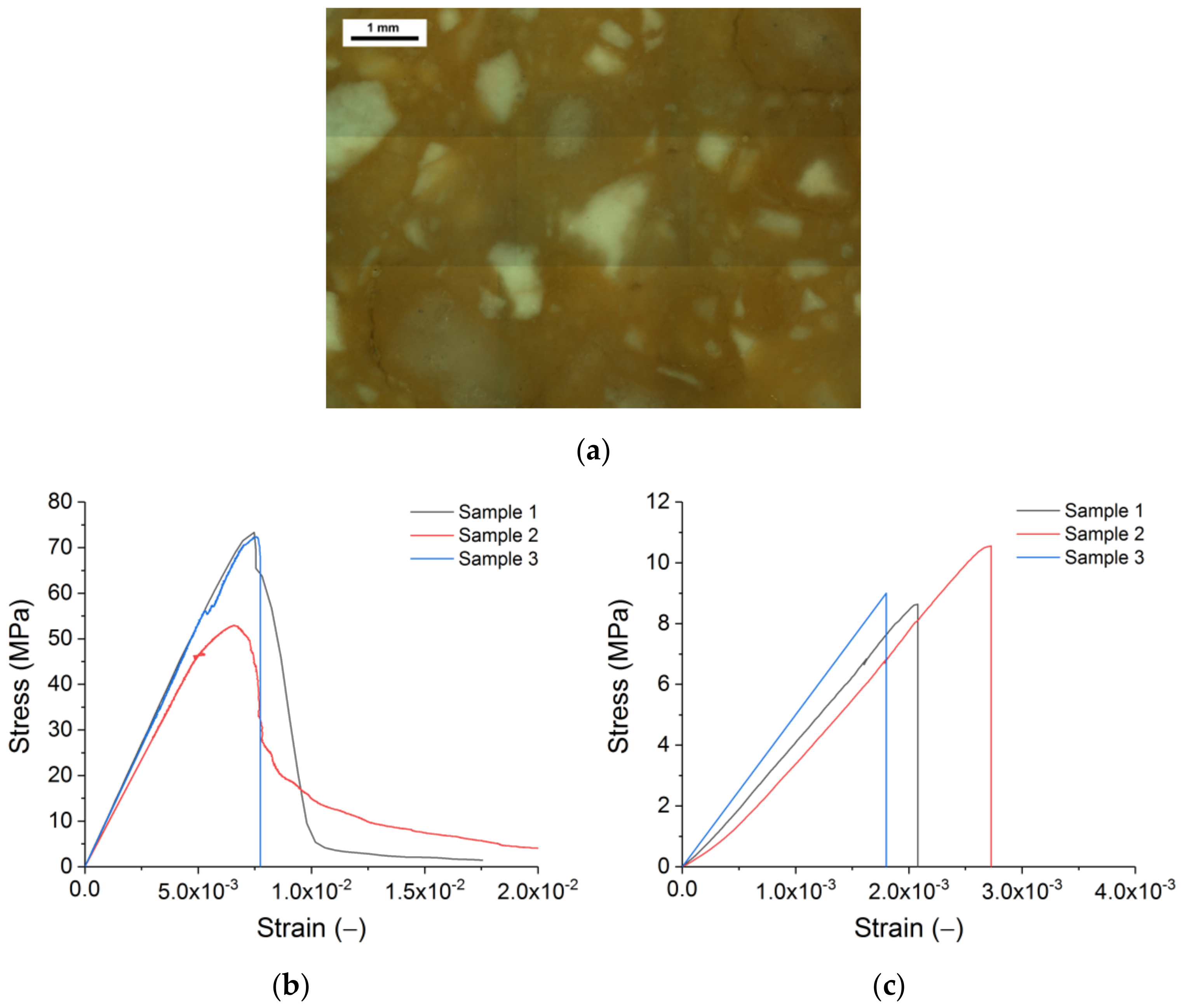
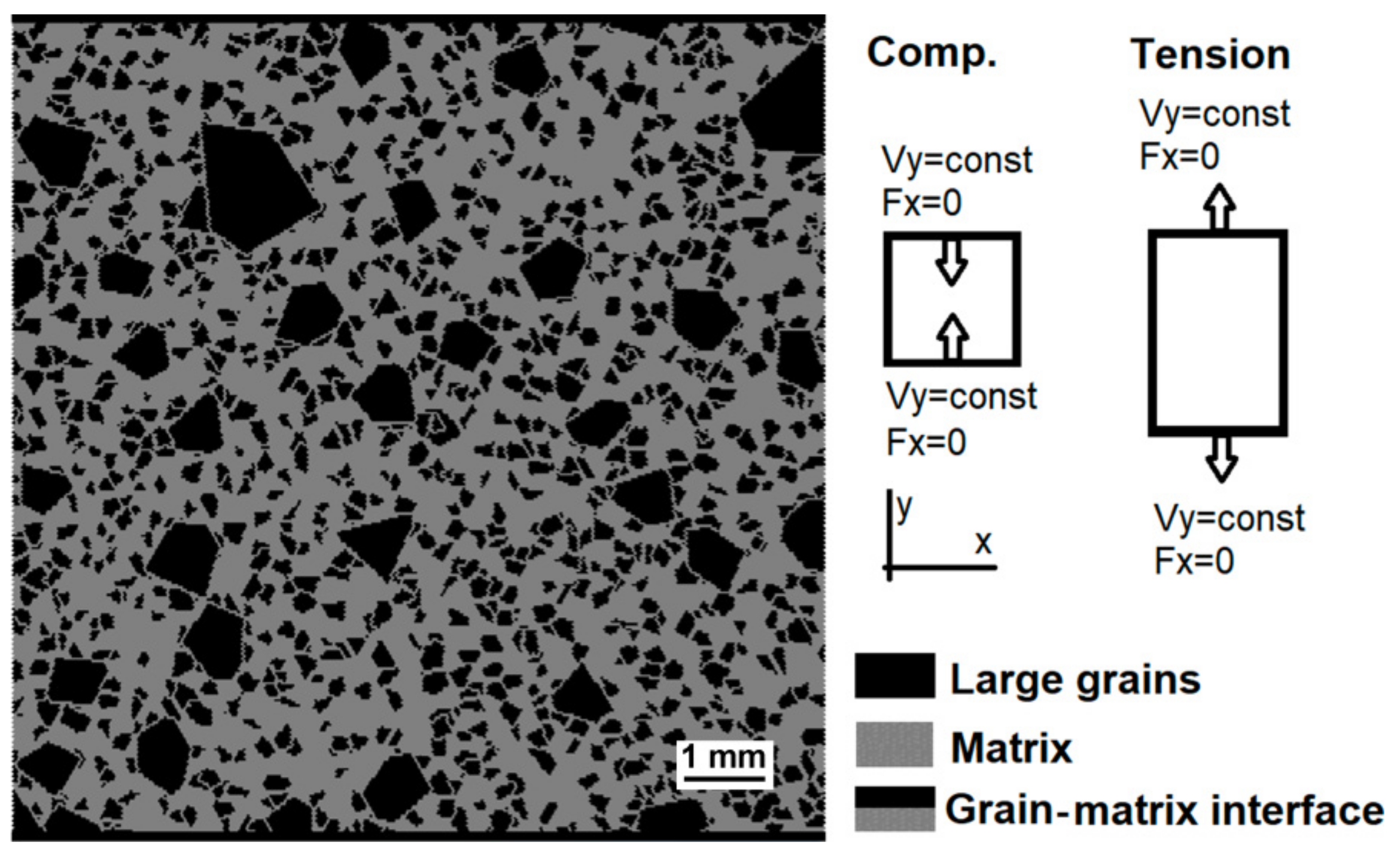


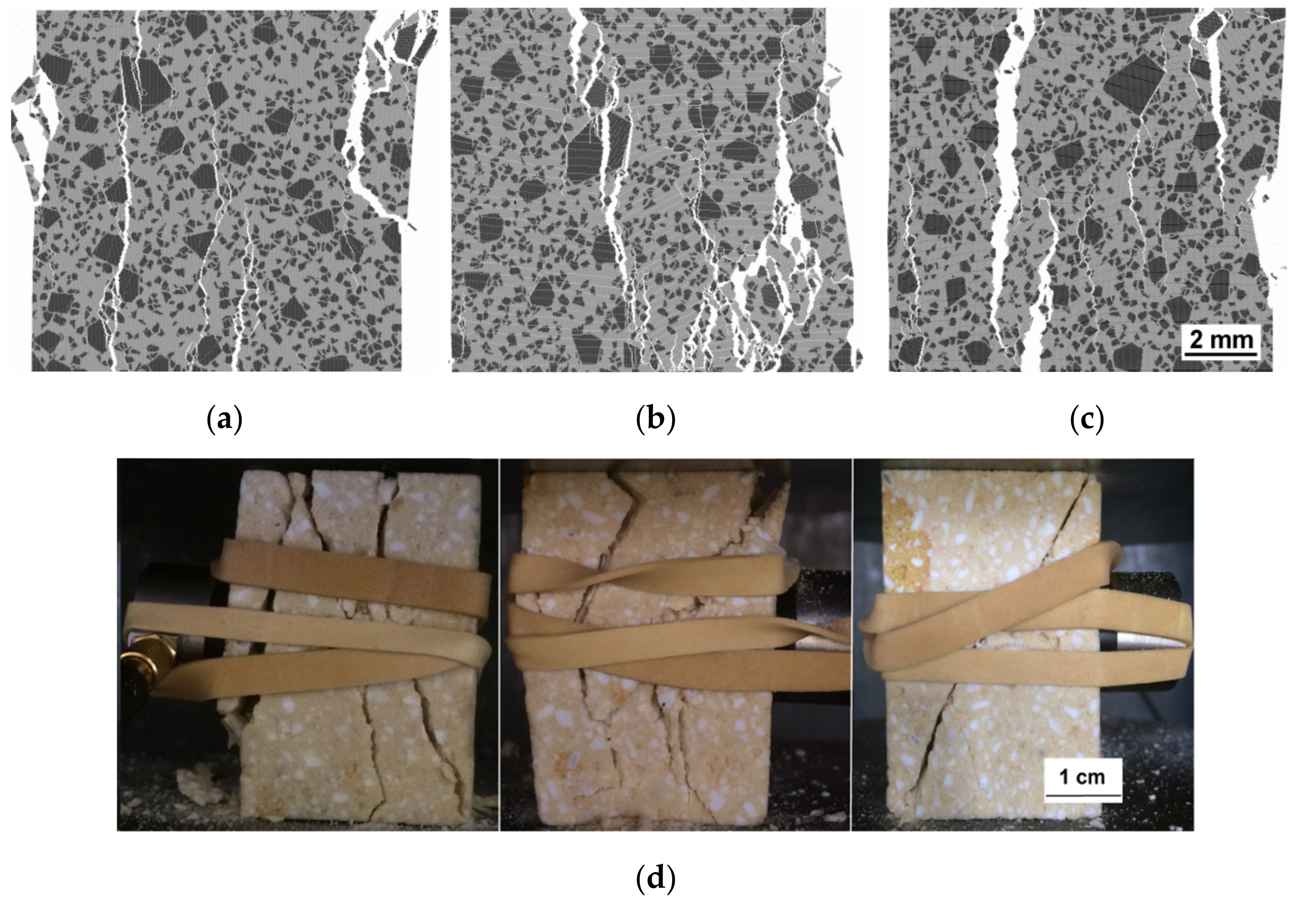

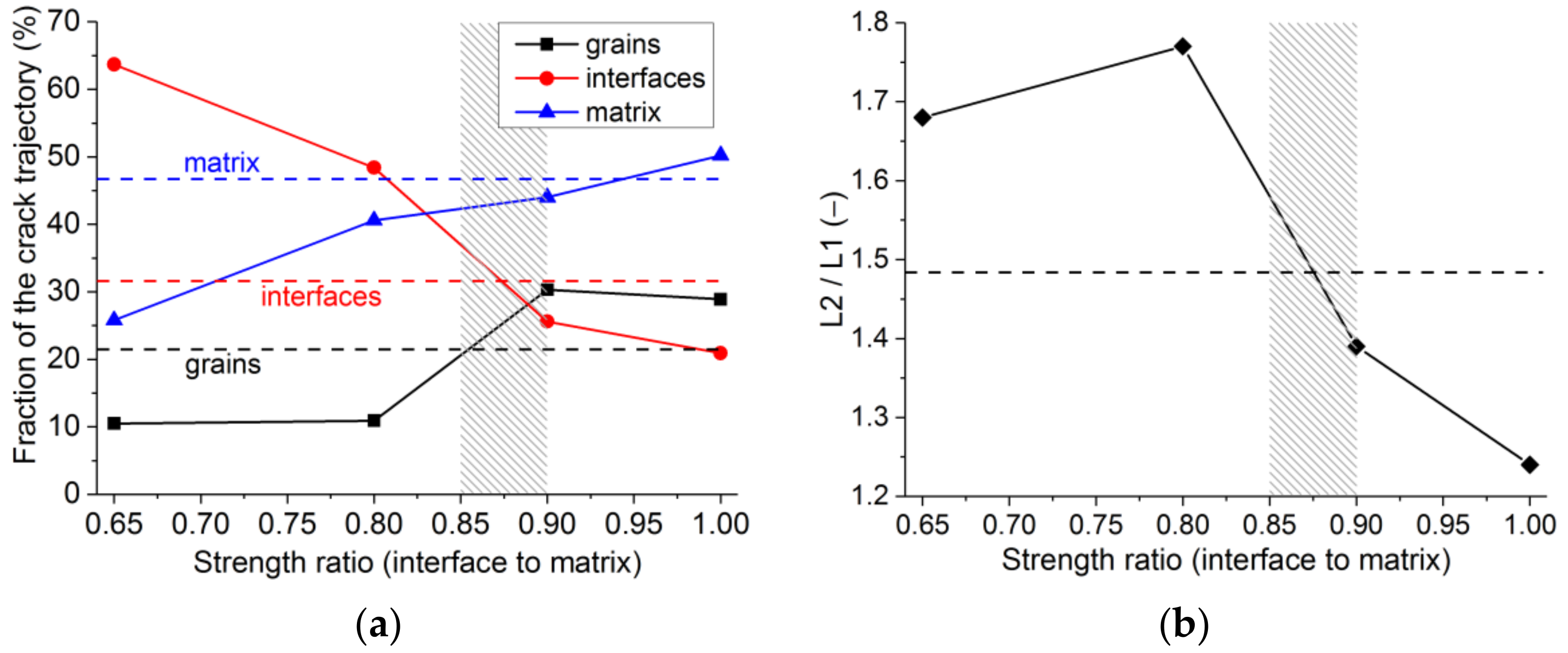

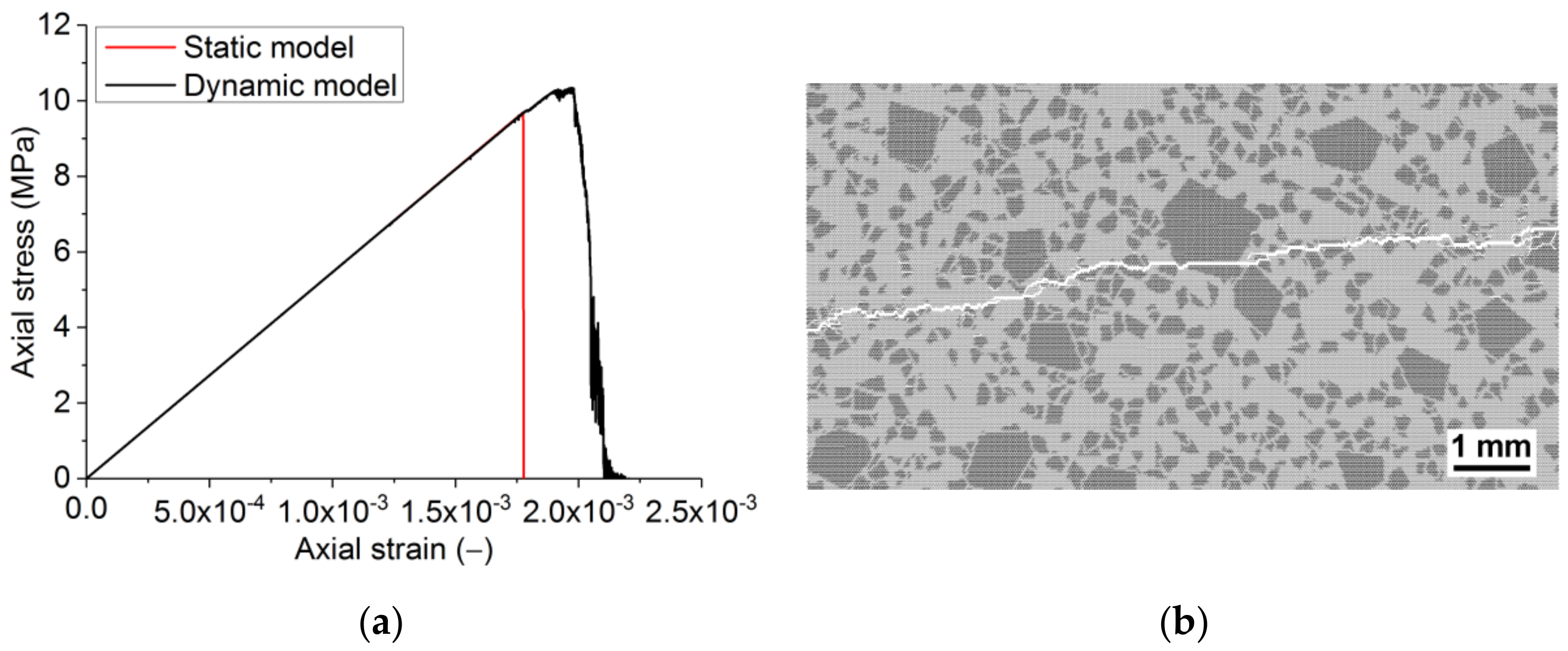
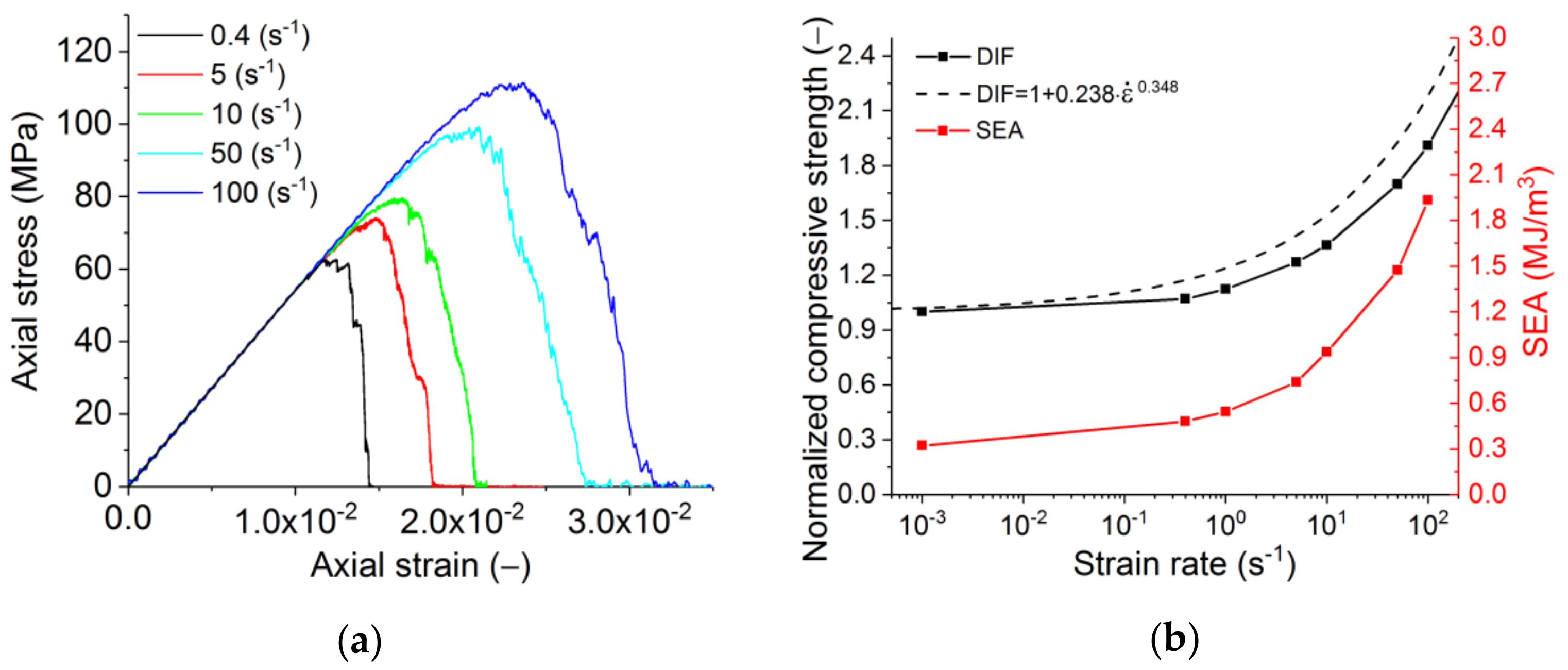
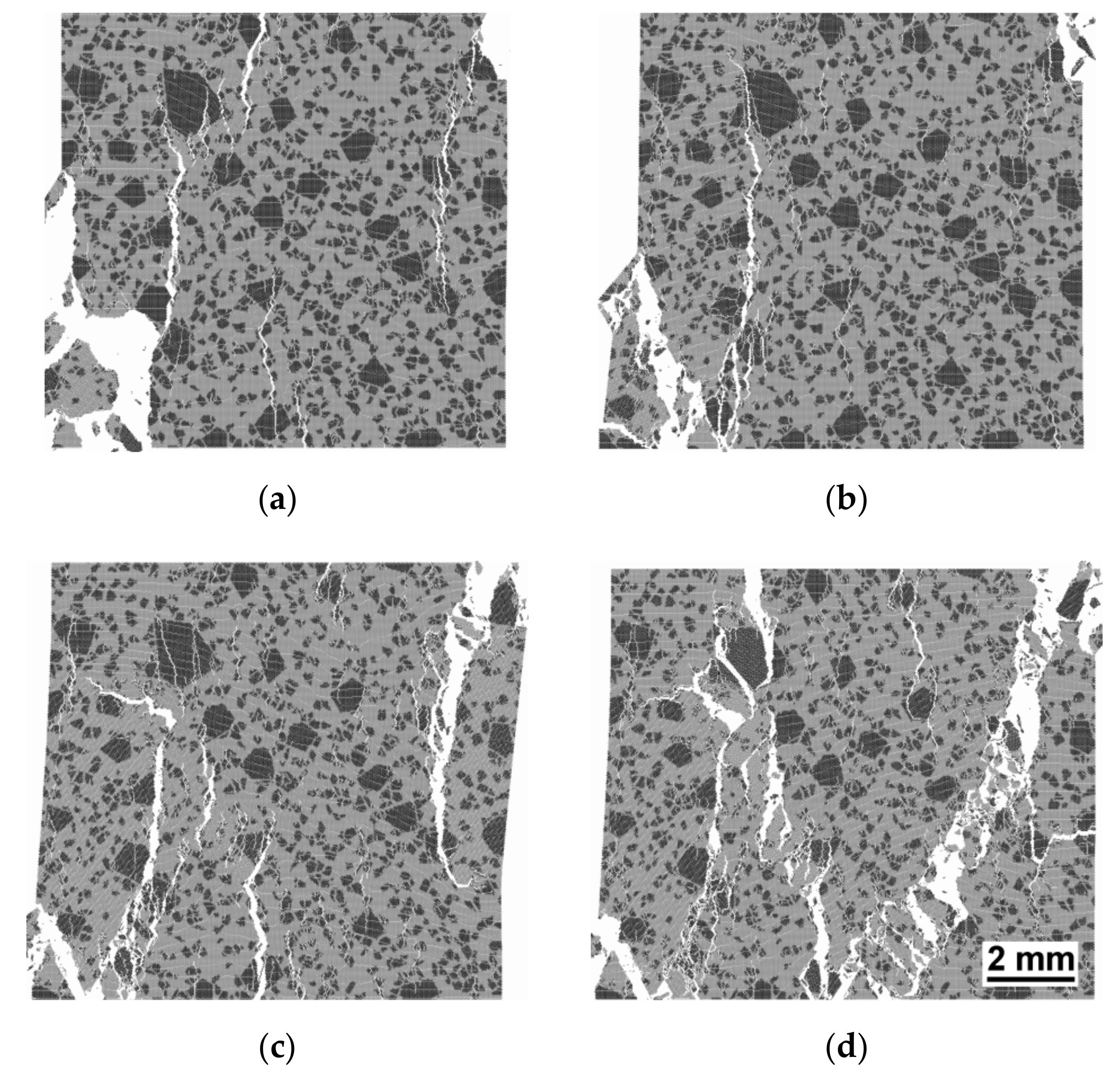
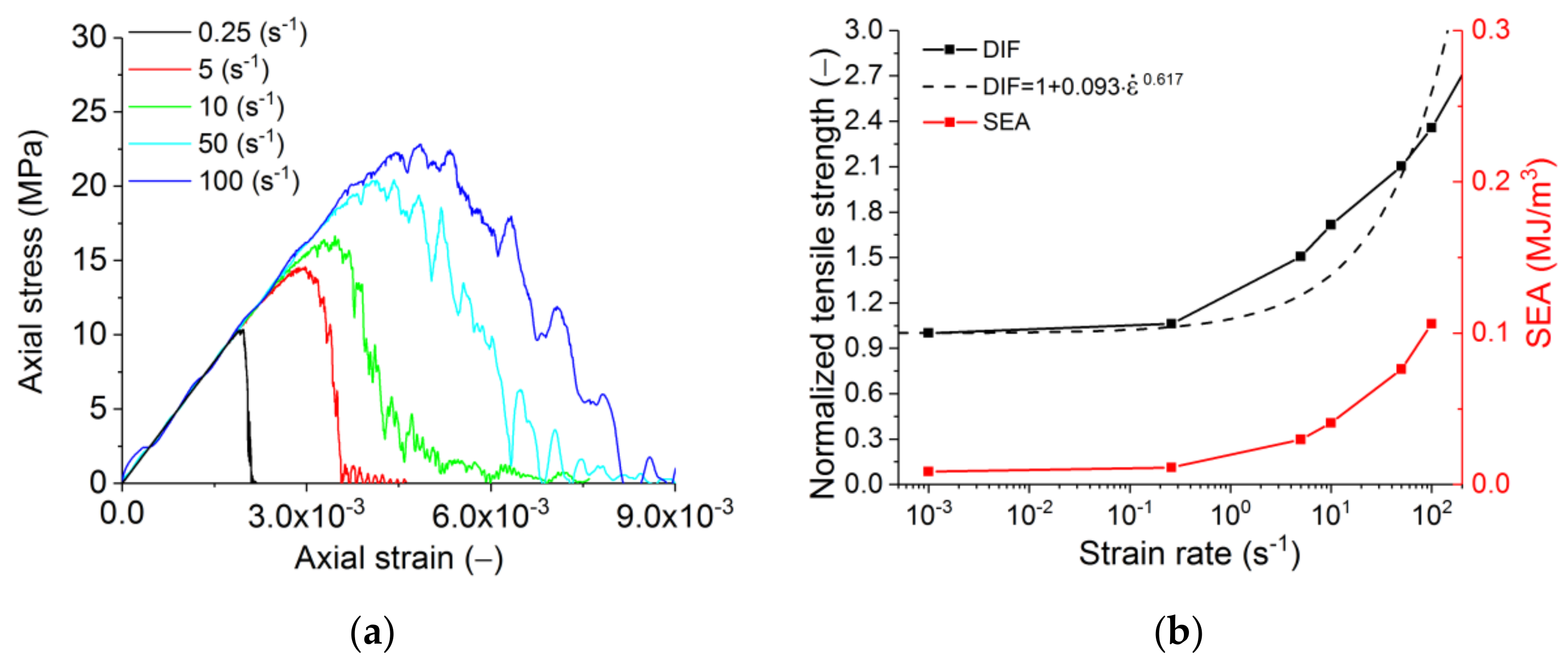
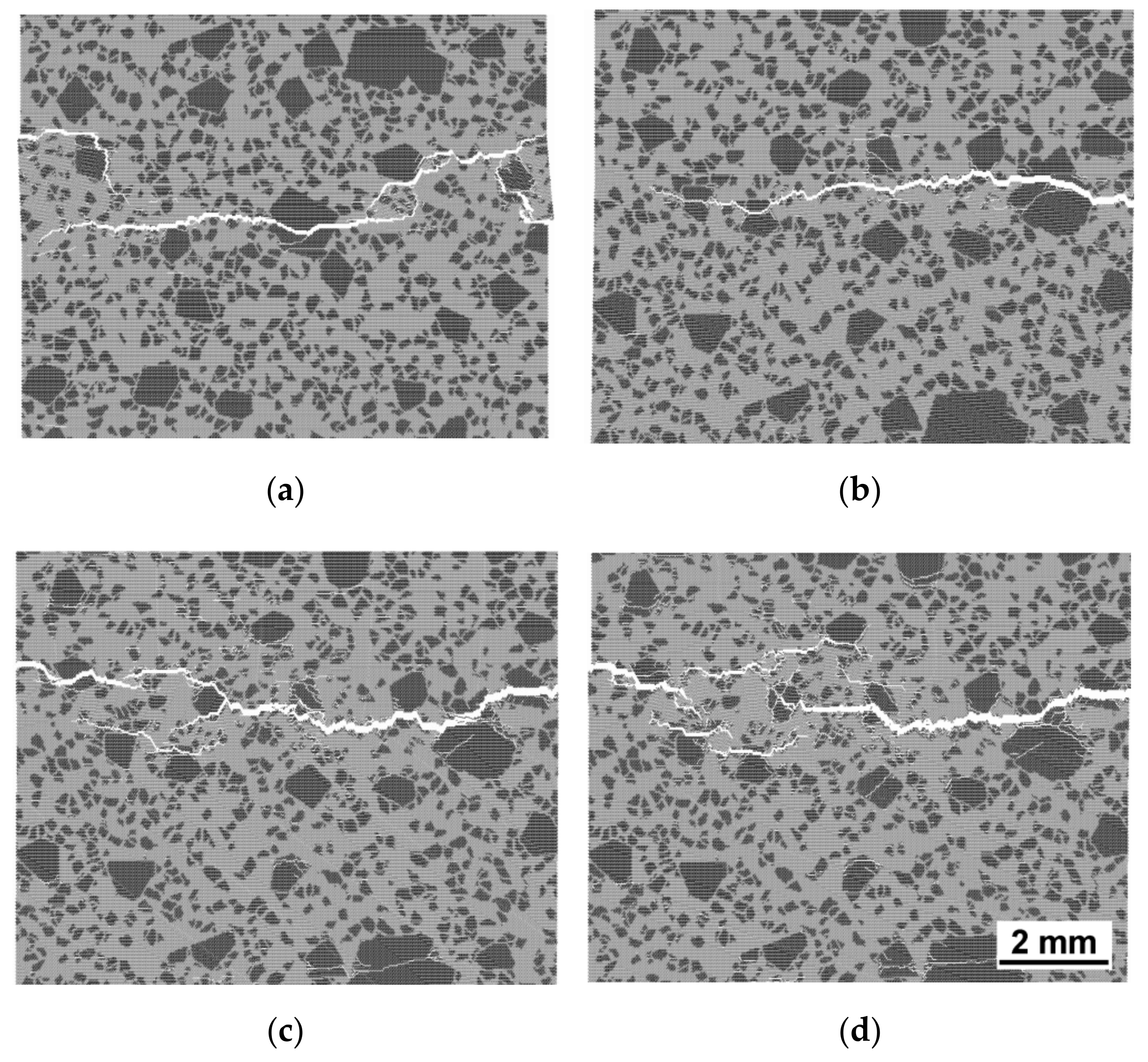
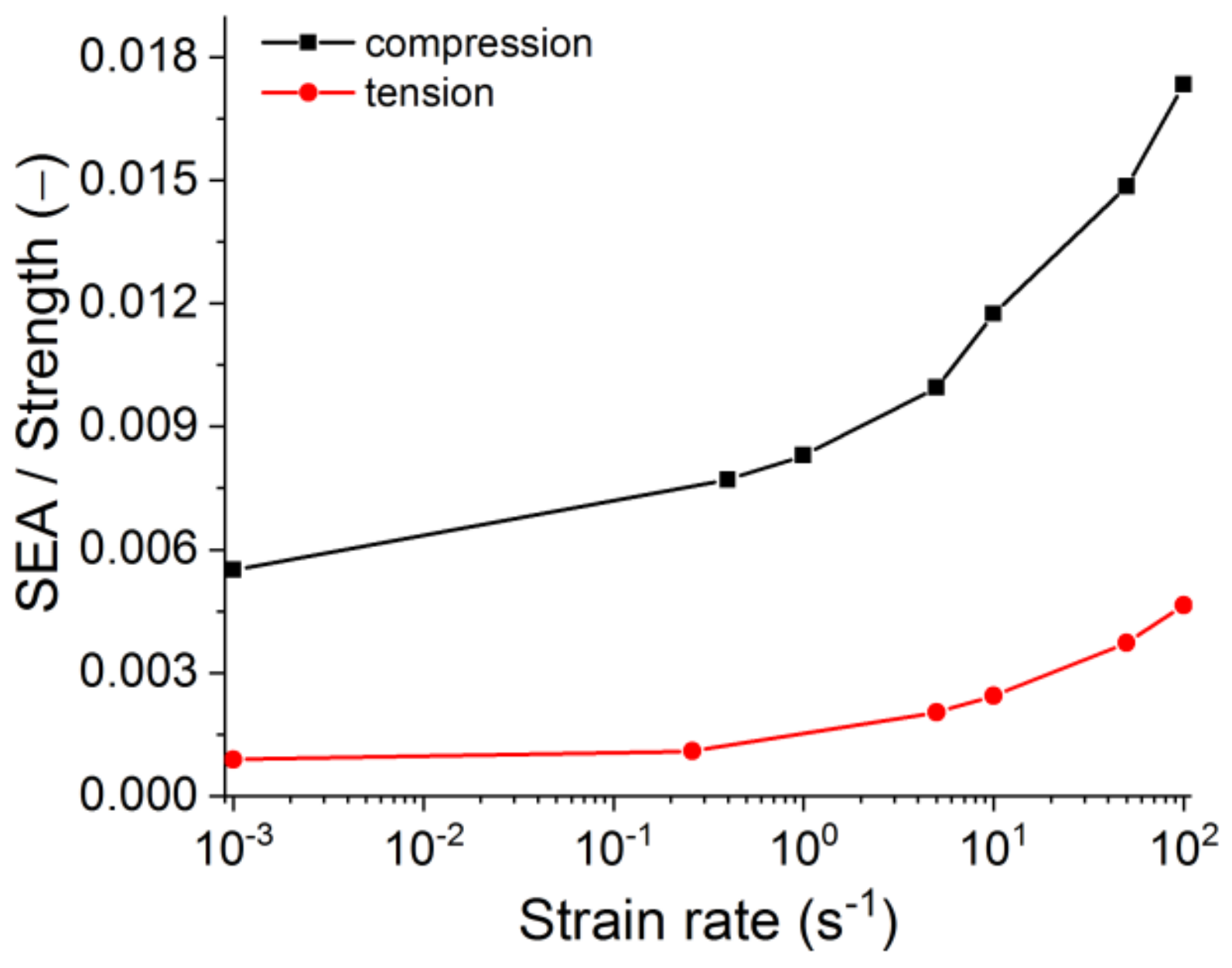
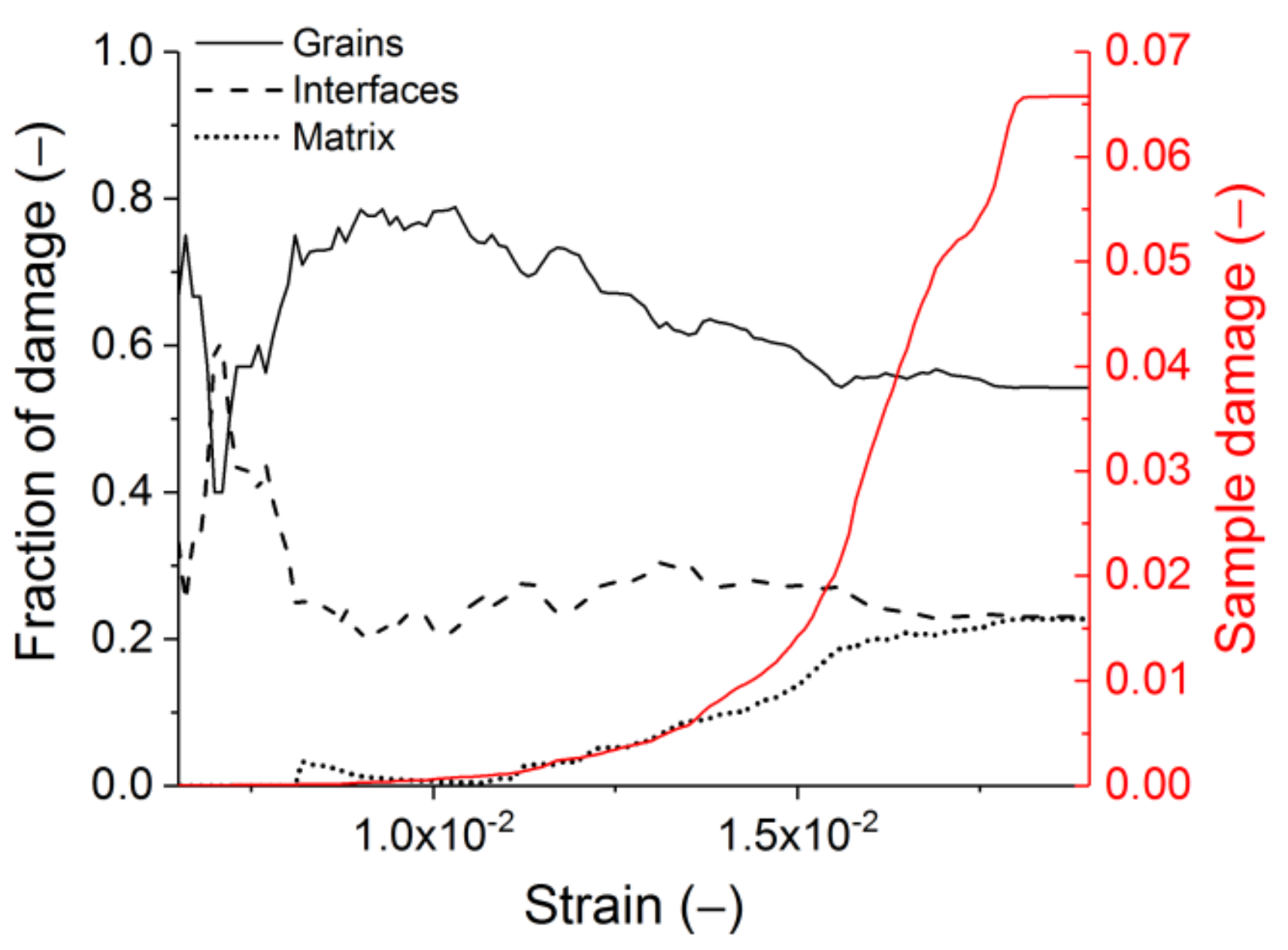
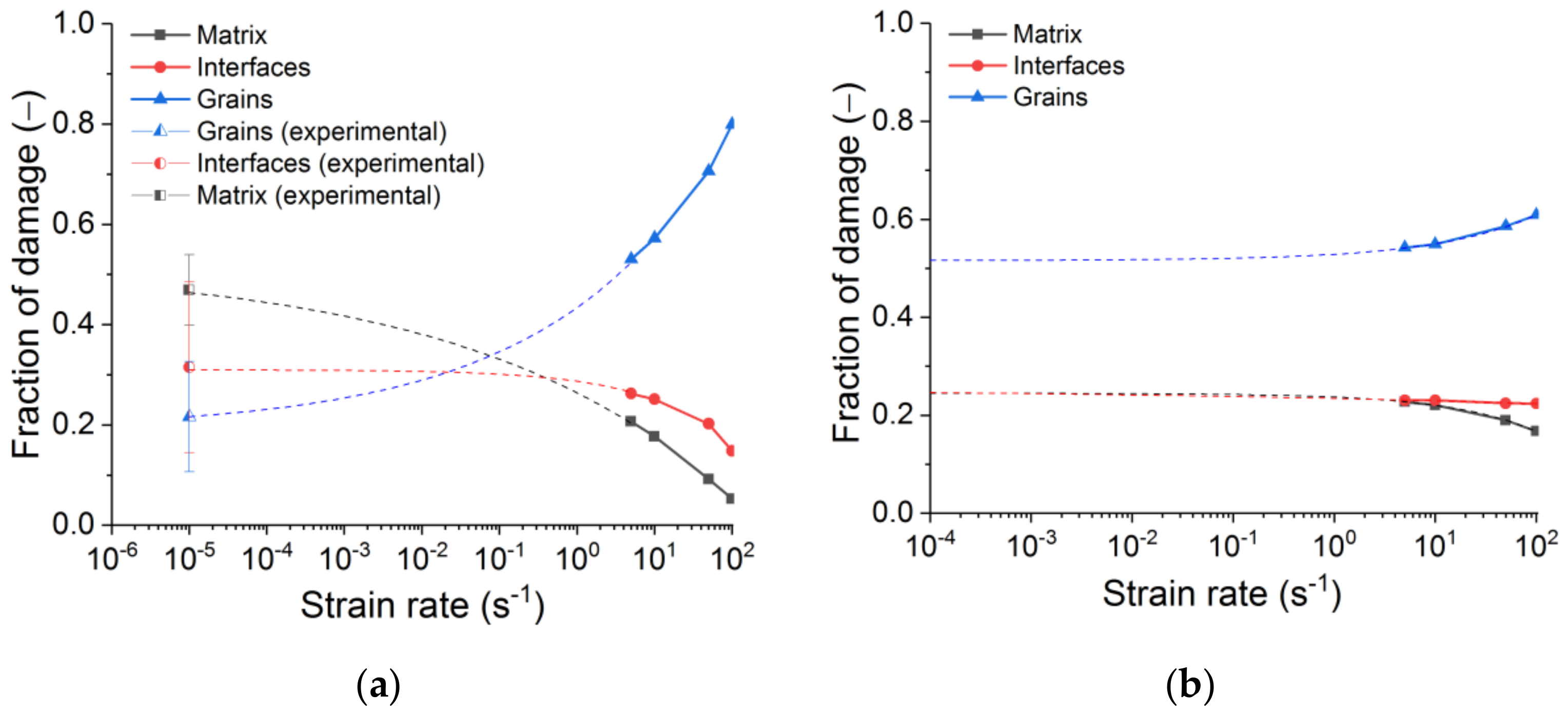
| Properties | Grains | Matrix | Interfaces |
|---|---|---|---|
| Density (kg/m3) | 2350 | 1670 | Not applicable |
| Young’s modulus (GPa) | 65 | 2.75 | Not applicable |
| Poisson’s ratio (-) | 0.2 | 0.2 | Not applicable |
| (MPa) | 8.5 | 5.4 | 3.6 |
| (MPa) | 34 | 21.6 | 14.4 |
| Parameter | Grains | Matrix | Interfaces |
|---|---|---|---|
| Vs (m/s) | 1700 | Not applicable | Not applicable |
| εmax | Not applicable | 0.00025 | 0.00025 |
| γmax | Not applicable | 0.00025 | 0.00025 |
| Strength/Strength | Grains/Matrix | Grains/Interfaces | Matrix/Interfaces |
|---|---|---|---|
| σt/σt | 1.574 | 2.361 | 1.5 |
| σc/σc | 1.574 | 2.361 | 1.5 |
| Strength | Grains | Matrix | Interfaces |
|---|---|---|---|
| (MPa) | 680 | 432 | 288 |
| (MPa) | 68 | 43.2 | 28.8 |
Publisher’s Note: MDPI stays neutral with regard to jurisdictional claims in published maps and institutional affiliations. |
© 2021 by the authors. Licensee MDPI, Basel, Switzerland. This article is an open access article distributed under the terms and conditions of the Creative Commons Attribution (CC BY) license (https://creativecommons.org/licenses/by/4.0/).
Share and Cite
Grigoriev, A.S.; Zabolotskiy, A.V.; Shilko, E.V.; Dmitriev, A.I.; Andreev, K. Analysis of the Quasi-Static and Dynamic Fracture of the Silica Refractory Using the Mesoscale Discrete Element Modelling. Materials 2021, 14, 7376. https://doi.org/10.3390/ma14237376
Grigoriev AS, Zabolotskiy AV, Shilko EV, Dmitriev AI, Andreev K. Analysis of the Quasi-Static and Dynamic Fracture of the Silica Refractory Using the Mesoscale Discrete Element Modelling. Materials. 2021; 14(23):7376. https://doi.org/10.3390/ma14237376
Chicago/Turabian StyleGrigoriev, Aleksandr S., Andrey V. Zabolotskiy, Evgeny V. Shilko, Andrey I. Dmitriev, and Kirill Andreev. 2021. "Analysis of the Quasi-Static and Dynamic Fracture of the Silica Refractory Using the Mesoscale Discrete Element Modelling" Materials 14, no. 23: 7376. https://doi.org/10.3390/ma14237376
APA StyleGrigoriev, A. S., Zabolotskiy, A. V., Shilko, E. V., Dmitriev, A. I., & Andreev, K. (2021). Analysis of the Quasi-Static and Dynamic Fracture of the Silica Refractory Using the Mesoscale Discrete Element Modelling. Materials, 14(23), 7376. https://doi.org/10.3390/ma14237376







